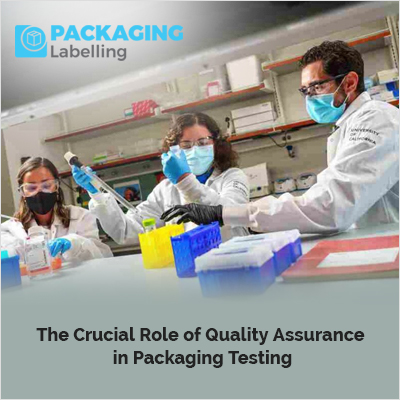The Crucial Role of Quality Assurance in Packaging Testing

Introduction:
Packaging plays a pivotal role in delivering products to consumers in a safe, secure, and visually appealing manner. The significance of packaging extends beyond just the physical protection of goods; it also influences brand perception and customer satisfaction. Quality Assurance (QA) in packaging testing is essential to ensure that packaging meets the required standards and performs its functions effectively. This article explores the importance of QA in packaging testing and its impact on product integrity, brand reputation, and regulatory compliance.
1. Product Integrity and Protection:
Maintaining integrity and safeguarding products is a pivotal goal achieved through the implementation of quality assurance in packaging testing. This entails a thorough examination of packaging materials, design, and construction to ensure their resilience against the demanding conditions of transportation, storage, and handling. Utilizing measures such as drop tests, vibration tests, and compression tests within the realm of quality assurance aids in detecting potential weaknesses in packaging. By addressing these identified issues, manufacturers can consistently uphold the quality and dependability of their products throughout the entirety of the supply chain.
2. Regulatory Compliance:
Adhering to regulatory standards in the dynamic packaging landscape is imperative due to the constantly changing and stringent requirements imposed by various authorities. Compliance with these regulations is not merely a legal obligation but also crucial for protecting consumers and the environment. Quality assurance in packaging testing plays a pivotal role in verifying that packaging materials align with the specified standards, encompassing aspects such as safety, recyclability, and labeling. Non-compliance with regulations can lead to consequences such as fines, product recalls, and reputational damage for a company.\
| Also Read: Ensuring Integrity: Cutting-Edge Packaging Testing Solutions for Quality Assurance |
3. Brand Reputation:
The visual presentation of a brand through packaging significantly shapes consumer perceptions and decisions. Inferior or flawed packaging has the potential to damage a brand's reputation, resulting in diminished customer trust and loyalty. Quality assurance in packaging testing serves a critical role in pinpointing concerns related to print quality, color uniformity, and overall aesthetics. Ensuring that packaging aligns seamlessly with the brand's image allows companies to fortify their brand identity and foster a positive consumer experience.
4. Cost Efficiency:
Implementing quality assurance practices in packaging testing can contribute to cost efficiency in the long run. By identifying and rectifying potential issues early in the design and production process, companies can avoid costly product recalls, rework, and legal consequences. Additionally, optimizing packaging materials and design through QA can lead to reduced packaging costs without compromising on quality or safety.
5. Sustainability Considerations:
In the context of the increasing emphasis on sustainability in the business sphere, quality assurance in packaging testing assumes a crucial role in evaluating the environmental repercussions of packaging materials and procedures. This involves appraising the recyclability of materials, minimizing unnecessary packaging, and investigating environmentally friendly alternatives. Companies that give precedence to sustainable packaging through quality assurance not only contribute to environmental preservation but also fulfill the rising consumer demand for eco-friendly products.
6. Supply Chain Efficiency:
Effective quality assurance in packaging testing contributes to the overall efficiency of the supply chain. Packaging that undergoes rigorous testing is less likely to fail during transportation and storage, reducing the risk of damaged goods. This, in turn, minimizes disruptions in the supply chain, enhances order fulfillment, and ensures that products reach their destination in optimal condition. By investing in QA, companies can streamline their logistics and distribution processes, ultimately improving customer satisfaction and maintaining strong relationships with retailers and distributors.
7. Innovation and Continuous Improvement:
Quality assurance in packaging testing catalyzes innovation and continuous improvement. Regular testing allows companies to identify areas for enhancement, whether it be in materials, design, or manufacturing processes. By analyzing test results and customer feedback, businesses can implement improvements, staying ahead of the competition and meeting evolving consumer expectations. The commitment to quality assurance fosters a culture of innovation, ensuring that packaging solutions remain cutting-edge and aligned with market trends.
8. Consumer Safety and Satisfaction:
Consumers expect products to be delivered in packaging that not only protects the contents but also ensures their safety. Quality assurance in packaging testing goes beyond physical durability; it involves evaluating factors such as chemical composition, potential allergens, and any other elements that might pose a risk to consumer health. By prioritizing these aspects through QA, companies demonstrate their commitment to consumer safety, leading to increased trust and satisfaction among customers.
9. Adaptability to Market Changes:
The ability to respond to swiftly changing market dynamics and evolving consumer preferences is essential. Quality assurance in packaging testing offers companies the flexibility needed to adapt effectively to these changes. Whether it involves adjusting packaging materials to align with new sustainability objectives or modifying designs to meet emerging aesthetic trends, QA facilitates prompt and well-informed decision-making. This adaptability guarantees that packaging remains pertinent and connects with the target audience, even amid a dynamic and competitive market.
10. Global Market Access:
For companies operating in the global marketplace, compliance with international standards is imperative. Quality assurance in packaging testing ensures that packaging meets the requirements of diverse markets and adheres to international regulations. This not only facilitates smoother market entry but also helps companies avoid costly setbacks resulting from non-compliance. Consistent adherence to global quality standards enhances a company's reputation as a reliable and responsible player in the international business arena.
Conclusion:
In essence, quality assurance in packaging testing extends beyond safeguarding product integrity, playing a pivotal role in diverse facets of a company's functioning. It encompasses regulatory compliance, cost-effectiveness, brand image, and customer contentment. In the current landscape characterized by elevated consumer demands and fierce market rivalry, implementing robust quality assurance measures is not merely a strategic choice but a fundamental requirement for sustained success. Companies acknowledging and giving precedence to the importance of QA in packaging testing position themselves adeptly to confront the intricacies of the contemporary business environment, ensuring a steadfast commitment to delivering top-notch products that align with regulatory standards.









